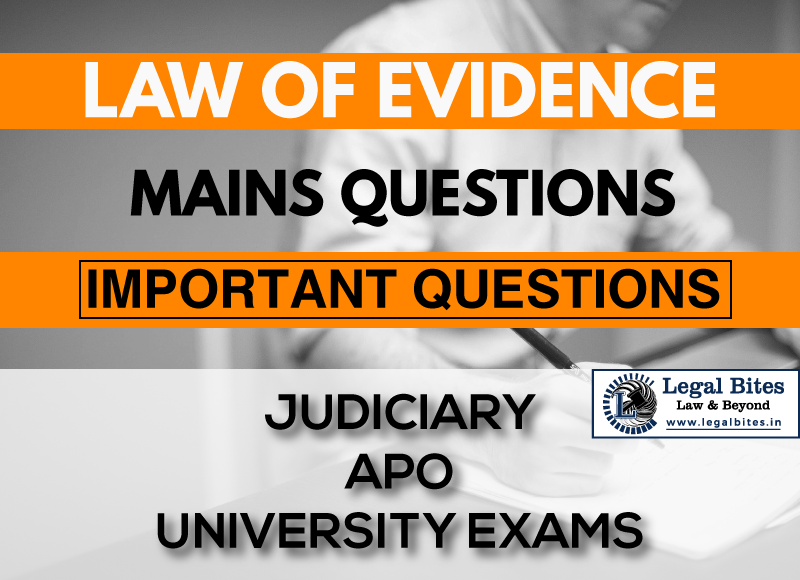Dying Declaration- Meaning, Explanation and Case Laws
This article titled ‘Dying Declaration- Meaning, Explanation and Case Laws’ is written by Saumya Chowdhary and discusses the law related to the dying declaration. I. Introduction Dying Declaration means a statement made regarding the cause of his death or the circumstances of the transaction which resulted in his death by a person on the death bed. In Uka Ram… Read More »
;
This article titled ‘Dying Declaration- Meaning, Explanation and Case Laws’ is written by Saumya Chowdhary and discusses the law related to the dying declaration. I. Introduction Dying Declaration means a statement made regarding the cause of his death or the circumstances of the transaction which resulted in his death by a person on the death bed. In Uka Ram v. State of Rajasthan (AIR 2001 SC 1814) Apex Court held that “when a statement is made by a person as to cause of...
This article titled ‘Dying Declaration- Meaning, Explanation and Case Laws’ is written by Saumya Chowdhary and discusses the law related to the dying declaration.
I. Introduction
Dying Declaration means a statement made regarding the cause of his death or the circumstances of the transaction which resulted in his death by a person on the death bed. In Uka Ram v. State of Rajasthan (AIR 2001 SC 1814) Apex Court held that “when a statement is made by a person as to cause of his death or as to any circumstance of transaction which resulted into his death, in the case in which cause of his death comes in question is admissible in evidence such statement in law is called a dying declaration.”
So that’s why these statements made by the person are allowed to be proved in court. The term ‘DYING DECLARATION’ has not been defined in the Evidence Act but reading Section 32 and sub-section (1) of Section 32; the term dying declaration may be defined as follows:
In Ram Bihari Yadav v. State of Bihar [AIR 1989 SC 702], it was held by the court that “A dying declaration is a statement made by a person who is dead; as to cause of his death or as to any circumstance of transaction which resulted in his death, in cases in which death comes into question, such statements are relevant under Section 32 of Evidence Act, whether the person who made there was or was not, at the time when they were made, under an exception of death and whatever may be the nature of the proceeding in which cause of his death came into question.”
II. Nemo moriturus praesumitur mentire
It is based on a principle named ‘nemo moriturus praesumitur mentire’ which simply means that when a person is on the death bed there are fewer chances that he would lie.
The Apex Court in its decision in P.V.Radhakrishna v. State of Karnataka [Appeal (crl.) 1018 of 2002] held that ‘the principle on which a dying declaration is admitted in evidence is indicated a Latin maxim, nemo moriturus praesumitur mentire, a man will not meet his maker with a lie in his mouth. Information lodged by a person who died subsequently relating to the cause of his death is admissible in evidence under this clause.
A dying declaration is also considered trustworthy evidence because it is believed that if a person knows that he is about to die he will not lie. That’s why it is admissible in evidence being hearsay evidence. This piece of hearsay evidence is admissible as an exception to the general rule of evidence that hearsay evidence is no evidence in the eye of law and it should be discarded as a general rule because the evidence in all cases must be direct.
III. Principles governing dying declaration
There is no format prescribed for recording a dying declaration. Indeed, no such format can be prescribed. The courts have laid down in several judgments the principles governing dying declaration, which can be summed up as under-
- There is neither rule of law nor prudence that dying declaration cannot be acted upon without corroboration. [Mannu Raja v. State of M.P. (1976) 2 SCR 764]
- If the Court is satisfied that the dying declaration is true and voluntary, it can base the conviction on it, without corroboration. [State of UP v. Ram Sagar Yadav, AIR 1985 SC 416]
- The court has to scrutinise the dying declaration carefully and must ensure that the declaration is not the result of tutoring, prompting or imagination. The deceased had the opportunity to observe and identify the assailants and was in a fit state to make the declaration. [Rama Chandran Reddy v. Public Prosecutor, AIR 1976 SC 1994]
- Where dying declaration is suspicious it should not be acted upon without corroborative evidence. [Rasheed Beg v. State of Madhya Pradesh, (1974) 4 SCC 264]
- A dying declaration can be the sole basis of the conviction if it inspires the full confidence of the court. [Atbir v. Govt. (NCT of Delhi), (2010) 9 SCC 1]
IV. Dying declaration made by nods and gestures
Dying declaration can also be in form of gestures and signs. In the case of Queen-Empress v. Abdullah [(1885) 7 All 385 FB] accused had cut the throat of the deceased girl and because of that, she was not able to speak so, she indicated the name of the accused by the signs of her hand, it was held by the full bench of the Allahabad High Court “If the injured person is unable to speak, he can make a dying declaration by signs and gestures in response to the question.”
V. The proximity of time between statement and death
There has to be a proximate relationship between the statement and the circumstances of death. In Sharad Bridhichand Sharda v. State of Maharashtra [(1984) 4 SCC 116], A young married woman had been speaking to her parents and other relatives and also writing to them expressing the danger to her life. She lost her life three or four months after that. Her statement was admitted as showing the circumstances of death. They were not too remote in time from the point of death.
VI. Language of dying declaration
Dying declaration recorded in the language of the declarant acquires added strength and reliability. [Najjam Faroqui v. State of W.B, 1992 Cr LJ 2574 (Cal)]
VII. FIR as dying declaration
In K. Ramachand Reddy v. Public Prosecutor [(1976) 3 S.C.C. 104], it was held that where an injured person lodged an FIR and then died, it was held to be relevant as a dying declaration.
According to Patel Hira Lal Joita Ram v. State of Gujarat (AIR 2000 SC 2944), by Section 32 (1) two categories of a statement are made admissible in evidence. They are-
- Cause of his death.
- Statement as to any circumstances of the transaction that resulted in his death.
1. Cause of his death
This clause lays down that when the statement is made by a person as to the cause of his death, or as to any of the circumstances of the transaction which resulted in his death, his statement would be relevant in a case in which the cause of his death is the point at issue.
EXAMPLE- A is assaulted and dies. Before his death, he makes a statement that “B assaulted him with a spear.” This statement of A is admissible as it relates to the cause of his death.
The interval between the statement and death is immaterial. If the statement relates to the cause of the deponent’s death it is admissible. But if there is nothing to show that the injuries to which the statement of the deceased related was the cause of his death the statement are not admissible as a dying declaration.
Declarant died of injury to be proved- Before the statement of a person as to cause of his death may be used as a dying declaration it must be proved that his death was caused by the injury he received in the incident for which the accused is being prosecuted.
In Chandra Bhan Singh v. State (1971 CrLJ 94), Chandra Bhan Singh was tried for the murder of Shaitan Singh. The deceased Shaitan Singh himself lodged a report in which he narrated the story of the incident. After the medical examination, the deceased developed tetanus and died of it, it was held that the statement of the deceased could not be used as a dying declaration.
2. Circumstances of the transaction that resulted in his death
The words “resulted in his death” do not mean ‘caused his death.’ The expression “any of the circumstances of the transaction which resulted in his death” is wider in scope than the expression “cause of death”. A statement not relating to the cause of death of its maker may be admissible if it relates to the circumstances of the transaction which resulted in his death. In a case of robbery, a statement made by a person before her death regarding the circumstance of the robbery is admissible. Although remotely, her death was caused by wounds received at the robbery.
Exception–
- If the deceased made statement before his death which is anything other than the cause of his death, then such declaration shall not be admissible in evidence.
- A dying declaration of a child is inadmissible.
- An inconsistent dying declaration is of no evidentiary value.
- A dying declaration should not be under influence of anyone.
Edited by- Akriti
References
- LAW OF EVIDENCE BY BATUK LAL
- LAW OF EVIDENCE BY AVTAAR SINGH
- SCC ONLINE


